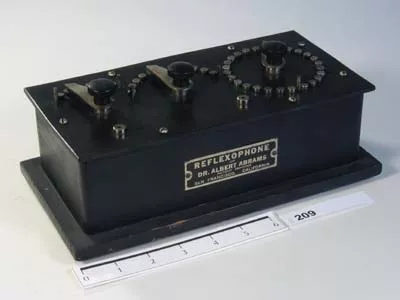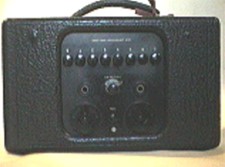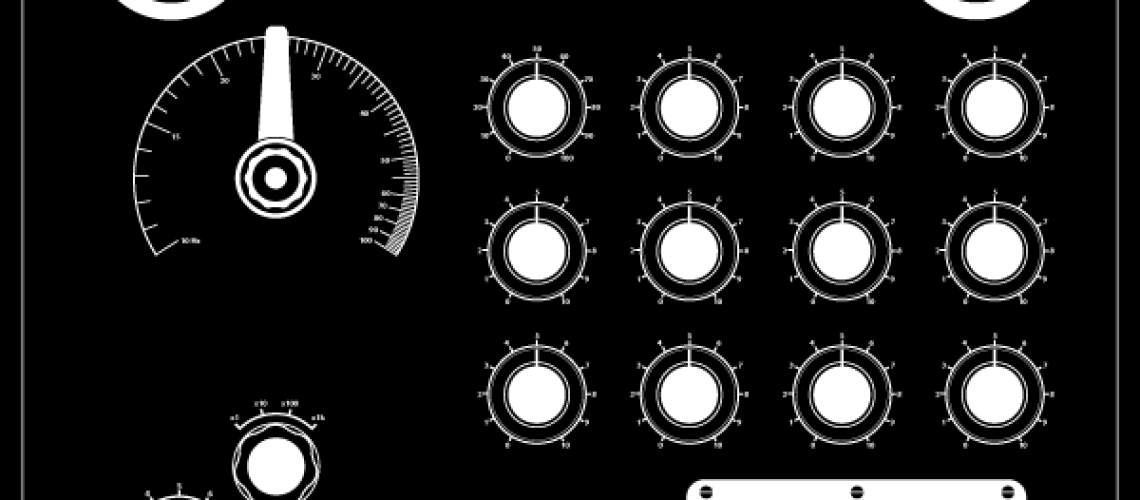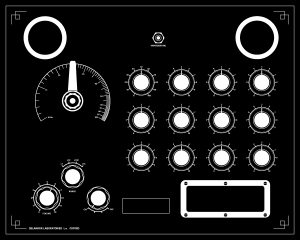Radionic devices have changed radically since the first designs were created in the early 1900’s by Albert Abrams. Today it is now possible to do so much more with integrated circuits and programable microcontrollers such as Arduino boards and many similar devices.
Early Radionic devices were relatively simple. For one of Abrams early devices a metal band was attached to the forehead and the patient would stand on a metal plate with bare feet. These plates would then be attached to the device itself. As part of the design, Abrams would also experiment with what were called “rheostats”. These were used to control the amount of current used between the device and the subject. These rheostats were made from bare wire wound around a tube or frame, bent into the shape of a curve. By rotating the tube and increasing the number of turns of resistance in the connection the device could be tuned. Abrams would soon abandon this simplistic design in favor of, other, more consistent ways to measure and control the resistance.
Probably the most easily identified as a Radionics box was Abrams Reflexophone device. The Reflexophone would use a witness sample from the patient and would be tuned much like a modern three dial box. Abrams would percuss a subject’s abdomen as his assistant would record the reactions as rate settings on the device.

As time went on the core design would remain largely the same. However, new additions would be made to the core design. The stick plate, for instance, has now become a common way to tune the device when attempting to find a rate for a subject.
The stick plate was first created by one of Abrams students, Earl Smith. At this time a glass rod would be connected to the Radionics box and would be used to find a “stick” on the body to set the rate. This was time consuming and generally uncomfortable for the person being treated. So, Smith experimented and found a far better solution. The stick plate design.
The stick plate was first made of glass with a wire coil on the underside that attached it to the device. Today other materials can be used however this basic design remains the same and the stick plate has become an almost universal part of any Radionics device. The plate would be stroked as each dial was adjusted. Once a stick was found then the next dial in the series would be tuned to eventually find the subject’s rate.
After this, the technology used in Radionic devices remained much the same with only small and incremental changes such as the use of potentiometers in the dials, vacuum tubes, and quarts or other crystals in the circuitry.
One somewhat obscure, yet noteworthy evolution in the history of Radionics was the work of Bob DeVries when he was commissioned by one Mrs. Packard to repair a Oscilloclast of a 1934 design.
In his recollections about his time working for Hewlett Packard Co. DeVries was contacted in 1975 by his friend Dave Baker. Baker wanted DeVries assistance with repairing a device that he had been given for repair at his shop.
DeVries studied and repaired what he would come to learn was an Oscilloclast created in 1934. DeVries noted that the device utilized two oscillators, one Hartley working in at 43 to 44 MHz range and another low frequency oscillator working around, 100 Hz/minute. He also noted that the RF oscillator was “turned on and off at a 60 Hertz rate and that 60 Hz rate was turned on and off at a 100 Hz/min. Rate.”

DeVries returned the now repaired Oscilloclast and was invited by Baker to meet the woman who owned the machine. DeVries found that Mrs. Packard (no relation to the owner of HP) was delightful company and they struck up a friendship. Mrs. Packard would ask DeVries to design an updated version of the device using more modern parts. While she had several other devices, each was large and heavy, with the one that DeVries worked on being twelve inches cubed and weighing in at roughly twenty pounds from his estimates.
While DeVries was a product designer and not a circuit designer his curiosity was piqued, and he took on the project. DeVries studied the various Abrams devices that Mrs. Packard owned and with some research and experimentation he was able to create a functioning version of the Oscilloclast on a bread board in roughly a month.
DeVries and Mrs. Packard would continue to correspond and would remain friends for 25 years until her passing. DeVries work on a modernized Oscilloclast culminated in what he would christen the Pulsed Oscilloclast. In 1998 a patent was filed under DeVries name along with two other designers. The patent, US20020156510A1 can be found here and it appears the DeVries found some potential in using his work with the Oscilloclast for suppressing tumors in mice. The data that DeVries patent presents is limited however, and far more trials and needed replication and review.
Yet, the line of inquiry continues in the Scientific community. They continue to explore this technology for treating various ailments, however, a lack of solid data prevents us from reaching conclusive answers as to its effectiveness for any disease.
Moving to the modern-day Radionics devices continue to evolve and change. Innovators and tinkerers in the field have created not only standalone Radionics software. Able to run many of the basic functions of a three-dial box from any computer. But also new designs, leveraging the power and flexibility of programmable micro controllers like Arduino.
Given the rapid change and growth in computer technology, even into the realm of quantum computers it is likely that we will see even more rapid change and innovation in the field of Radionics.



